| کد مقاله | کد نشریه | سال انتشار | مقاله انگلیسی | نسخه تمام متن |
|---|---|---|---|---|
| 5797516 | 1555236 | 2016 | 9 صفحه PDF | دانلود رایگان |
- Treatment of canine atopic dermatitis must be individualised for each patient.
- Control and prevention of secondary bacterial and yeast infections are essential.
- Food allergies should be investigated in all cases with non-seasonal signs.
- Glucocorticoids, cyclosporine and oclacitinib are the most effective systemic drugs.
- Multiple treatment modalities may have to be combined for optimal results.
Canine atopic dermatitis is a common skin disease seen in veterinary clinical practice. Several factors appear to contribute to the cutaneous inflammation and pruritus. The therapeutic strategy should focus on control of those factors that can be identified and for which interventional measures are feasible; these include ectoparasites, bacterial/fungal infection and dietary hypersensitivity. Ectoparasites, particularly fleas, are not the cause of atopic dermatitis, but they are a confounding factor, which can exacerbate pruritus, and preventative measures are therefore indicated. Bacterial and yeast infections are frequently associated with atopic dermatitis and initial systemic and/or topical therapy should be considered, followed by regular topical treatment for preventing relapse. Concurrent dietary hypersensitivity should be investigated by undertaking an elimination/provocation trial, followed by feeding of a hypoallergenic diet where appropriate.Depending on the severity of the clinical signs of atopic dermatitis and the willingness and expectations of owners, symptomatic treatment and/or specific interventional therapy for environmental allergy (allergen avoidance, allergen-specific immunotherapy) may be implemented. Symptomatic treatment includes use of glucocorticoids (systemically or topically), ciclosporin and oclacitinib. Other treatment modalities of lower or less proven efficacy include antihistamines, dextromethorphan, fatty acids, feline interferon-omega, misoprostol, pentoxifylline, specific serotonin re-uptake inhibitors and tricyclic antidepressant drugs. The therapeutic approach should be reviewed at regular intervals and tailored to the individual's needs. A successful long-term outcome can usually be achieved by combining the various treatment approaches in a way that maximises their benefits and minimises their drawbacks.
Graphical Abstract101
Journal: The Veterinary Journal - Volume 207, January 2016, Pages 29-37
